Experimental Investigation on Mechanical and Acoustic Emission Characteristics of Gassy Coal under Different Stress Paths
Abstract
1. Introduction
2. Materials and Methods
2.1. Experimental System
2.1.1. Triaxial Loading and Unloading System
2.1.2. AE Monitoring System
2.2. Sample Preparation
2.3. Experimental Program
- The stress of 1 MPa was applied to the chamber at the axial direction. Then, the coal and chamber were vacuumed for 8 h, and gas at the pressure of 0.2 MPa, 0.5 MPa, and 0.8 MPa was injected into the chamber and absorbed for 24 h.
- Before the test, the AE sensors were placed on both sides of the axial rigid pressure bar and fixed with magnetic suction. The sensor and the pressure bar were connected via Vaseline. After that, pencil lead break was made to ensure that the AE signal could be adequately collected. The preamplifier threshold was set to 45 dB. A slight tap before the experiment was performed to determine that the two channels could acquire the AE signal well.
- The conventional triaxial test applied stress to = = = 19 MPa using the hydrostatic loading method, and the axial pressure was increased to the sample failure at a loading speed of 500 N/s. The strength of the coal sample was obtained.
- In the experiments, the stress of , , and were synchronously applied to 19 MPa, then the axial stress was increased to 80–90% of the conventional triaxial strength. After that, and were simultaneously unloaded at 0.01 MPa/s and 0.005 MPa/s, respectively, until the sample failure. AE data acquisition took place during the entire loading process of the conventional triaxial text. For the unloading test, AE data acquisition was started after = 12 MPa. All data were collected until the sample failed.
3. Results
3.1. Conventional Triaxial Test
3.1.1. Mechanical Properties and Deformation Characteristics
3.1.2. Acoustic Emission Characteristics
3.2. Fixed Axial Stress and Unloading Confining Stress
3.2.1. Mechanical Properties and Deformation Characteristics
3.2.2. Acoustic Emission Characteristics
4. Discussion
4.1. Damage Based on AE Ring-Down Counts
4.1.1. Damage Model
4.1.2. Damage Analysis
4.2. Effect of Gas Pressure on Mechanical Behavior of Coal Samples
5. Conclusions
- Gas pressure obviously influenced the peak strength of gas-bearing coal in the CTS experiments. The peak strength of gas-bearing coal decreases from 68.46 MPa at 0.2 MPa to 40.04 MPa at 0.8 MPa. With the increase in gas pressure, the speed from crack expansion to complete failure of gas-bearing coal is accelerated.
- Acoustic emission of gas-bearing coal in the CTS experiments can be divided into three stages: quiet period, active period, and acceleration period. The duration time of the quiet period and the active period becomes longer with the increase in gas pressure.
- The bearing capacity of the samples decreased significantly under the fixed axial unloading confining pressure path. When the gas pressure increases from 0.2 MPa to 0.8 MPa, the maximum of stress difference (-) decreases from 53.42 MPa to 36.66 MPa, and the maximum of stress difference (-) decreases from 44.43 MPa to 25.83 MPa. Before unloading the confining pressure, the volume of the sample compresses with the increase in axial stress, and the volumetric strain increases continuously. The volume expands when the confining stress unloaded, and the expansion of the sample along the direction of the minimum principal stress is significantly higher than that of the intermediate principal stress. With the increase in gas pressure, the Poisson’s ratio decreases continuously.
- In the FASUCS experiments, the boundary between the quiet period and the active stage of acoustic emission signals is blurred, and paroxysmal signals are generated occasionally during this process. After entering the rapid fracture stage of the sample, ring-down count and energy of the AE accelerated and increased continuously. With the increase in gas pressure, the duration of the accelerating rising stage is shortened.
- Taking acoustic emission ring-down count as the damage variable, the stress–strain constitutive equation was established, and the calculated stress variation trend was consistent with the experimental results. The trends in calculated stress and damage coefficient D are consistent with the stress path during unloading, and both begin to rise sharply after the sample enters the plastic stage.
Author Contributions
Funding
Institutional Review Board Statement
Informed Consent Statement
Data Availability Statement
Acknowledgments
Conflicts of Interest
References
- Liu, J.; Zhang, R.; Song, D.; Wang, Z. Experimental Investigation on Occurrence of Gassy Coal Extrusion in Coalmine. Saf. Sci. 2019, 113, 362–371. [Google Scholar] [CrossRef]
- Sa, Z.; Liu, J.; Li, J.; Zhang, Y. Research on Effect of Gas Pressure in the Development Process of Gassy Coal Extrusion. Saf. Sci. 2019, 115, 28–35. [Google Scholar] [CrossRef]
- Li, X.; Cao, Z.; Xu, Y. Characteristics and Trends of Coal Mine Safety Development. Energy Sources Part A Recovery Util. Environ. Eff. 2020, 1–19. [Google Scholar] [CrossRef]
- Liu, J.; Wang, E.; Song, D.; Wang, S.; Niu, Y. Effect of Rock Strength on Failure Mode and Mechanical Behavior of Composite Samples. Arab. J. Geosci. 2015, 8, 4527–4539. [Google Scholar] [CrossRef]
- Lu, S.; Zhang, Y.; Sa, Z.; Si, S.; Shu, L.; Wang, L. Damage-Induced Permeability Model of Coal and Its Application to Gas Predrainage in Combination of Soft Coal and Hard Coal. Energy Sci. Eng. 2019, 7, 1352–1367. [Google Scholar] [CrossRef]
- Lu, S.; Wang, C.; Liu, Q.; Zhang, Y.; Liu, J.; Sa, Z.; Wang, L. Numerical Assessment of the Energy Instability of Gas Outburst of Deformed and Normal Coal Combinations during Mining. Process Saf. Environ. Protect. 2019, 132, 351–366. [Google Scholar] [CrossRef]
- Lu, S.; Zhang, Y.; Sa, Z.; Si, S. Evaluation of the Effect of Adsorbed Gas and Free Gas on Mechanical Properties of Coal. Environ. Earth Sci. 2019, 78, 218. [Google Scholar] [CrossRef]
- Xie, H.-P.; Zhou, H.-W.; Liu, J.-F.; Gao, F.; Zhang, R.; Xue, D.-J.; Zhang, Y. Mining-Induced Mechanical Behavior in Coal Seams under Different Mining Layouts. Meitan Xuebao J. China Coal Soc. 2011, 36, 1067–1074. [Google Scholar]
- Wen, Z.; Xing, E.; Shi, S.; Jiang, Y. Overlying Strata Structural Modeling and Support Applicability Analysis for Large Mining-Height Stopes. J. Loss Prev. Process Ind. 2019, 57, 94–100. [Google Scholar] [CrossRef]
- Zhang, M.; Lin, M.; Zhu, H.; Zhou, D.; Wang, L. An Experimental Study of the Damage Characteristics of Gas-Containing Coal under the Conditions of Different Loading and Unloading Rates. J. Loss Prev. Process Ind. 2018, 55, 338–346. [Google Scholar] [CrossRef]
- Lu, S.; Wang, C.; Li, M.; Sa, Z.; Zhang, Y.; Liu, J.; Wang, H.; Wang, S. Gas Time-Dependent Diffusion in Pores of Deformed Coal Particles: Model Development and Analysis. Fuel 2021, 295, 120566. [Google Scholar] [CrossRef]
- Qiu, L.; Song, D.; He, X.; Wan, E.; Li, Z.; Yi, S.; We, M.; Li, Y. Multifractal of Electromagnetic Waveform and Spectrum About Coal Rock Samples Subjected to Uniaxial Compression. Fractals-Complex Geom. Patterns Scaling Nat. Soc. 2020, 28, 2050061. [Google Scholar] [CrossRef]
- Qiu, L.; Liu, Z.; Wang, E.; He, X.; Feng, J.; Li, B. Early-Warning of Rock Burst in Coal Mine by Low-Frequency Electromagnetic Radiation. Eng. Geol. 2020, 279, 105755. [Google Scholar] [CrossRef]
- Kwaśniewski, M. Recent Advances in Studies of the Strength of Rocks Under True Triaxial Compression Conditions / POSTĘPY W Badaniach Nad WYTRZYMAŁOŚCIĄ SKAŁ W Warunkach Prawdziwego TRÓJOSIOWEGO ŚCISKANIA. Arch. Min. Sci. 2013, 58, 1177–1200. [Google Scholar] [CrossRef][Green Version]
- Taheri, A.; Squires, J.; Meng, Z.; Zhang, Z. Mechanical Properties of Brown Coal under Different Loading Conditions. Int. J. Geomech. 2017, 17, 06017020. [Google Scholar] [CrossRef]
- Palm, J.H. Stress-Strain Relations for Uniform Monotonic Deformation under Triaxial Loading. Appl. Sci. Res. 1951, 2, 54. [Google Scholar] [CrossRef]
- Taheri, A.; Sasaki, Y.; Tatsuoka, F.; Watanabe, K. Strength and Deformation Characteristics of Cement-Mixed Gravelly Soil in Multiple-Step Triaxial Compression. Soils Found. 2012, 52, 126–145. [Google Scholar] [CrossRef]
- Bruning, T.; Karakus, M.; Nguyen, G.D.; Goodchild, D. Experimental Study on the Damage Evolution of Brittle Rock Under Triaxial Confinement with Full Circumferential Strain Control. Rock Mech. Rock Eng. 2018, 51, 3321–3341. [Google Scholar] [CrossRef]
- Chen, J.; Du, C.; Jiang, D.; Fan, J.; He, Y. The Mechanical Properties of Rock Salt under Cyclic Loading-Unloading Experiments. Geomech. Eng. 2016, 10, 325–334. [Google Scholar] [CrossRef]
- Pirzada, M.A.; Zoorabadi, M.; Ramandi, H.L.; Canbulat, I.; Roshan, H. CO2 Sorption Induced Damage in Coals in Unconfined and Confined Stress States: A Micrometer to Core Scale Investigation. Int. J. Coal Geol. 2018, 198, 167–176. [Google Scholar] [CrossRef]
- Wang, W.-Z.; Yin, G.-Z.; Wang, D.-K.; Qin, H. A Visco-Elasto-Plastic Creep Model of Outburst Prone Coal under Triaxial Compression. Chongqing Daxue Xuebao J. Chongqing Univ. 2010, 33, 99–103. [Google Scholar]
- Xu, Y.; Kang, H.; Zhang, H.; Wang, W. Experimental Study of Mechanical Properties of Coal Containing Gas under Unloading Conditions. Yanshilixue Yu Gongcheng Xuebao Chin. J. Rock Mech. Eng. 2014, 33, 3476–3488. [Google Scholar] [CrossRef]
- He, S.; Song, D.; Li, Z.; He, X.; Chen, J.; Li, D.; Tian, X. Precursor of Spatio-Temporal Evolution Law of MS and AE Activities for Rock Burst Warning in Steeply Inclined and Extremely Thick Coal Seams Under Caving Mining Conditions. Rock Mech. Rock Eng. 2019, 52, 2415–2435. [Google Scholar] [CrossRef]
- Wang, X.; Wen, Z.; Jiang, Y.; Huang, H. Experimental Study on Mechanical and Acoustic Emission Characteristics of Rock-Like Material Under Non-Uniformly Distributed Loads. Rock Mech. Rock Eng. 2018, 51, 729–745. [Google Scholar] [CrossRef]
- Li, X.; Chen, S.; Wang, E.; Li, Z. Rockburst Mechanism in Coal Rock with Structural Surface and the Microseismic (MS) and Electromagnetic Radiation (EMR) Response. Eng. Fail. Anal. 2021, 124, 105396. [Google Scholar] [CrossRef]
- Dunegan, H.L.; Harris, D.O.; Tatro, C.A. Fracture Analysis by Use of Acoustic Emission. Eng. Fract. Mech. 1968, 1, 105–122. [Google Scholar] [CrossRef]
- Kong, X.; Wang, E.; He, X.; Liu, X.; Li, D.; Liu, Q. Cracks Evolution and Multifractal of Acoustic Emission Energy during Coal Loading. Geomech. Eng. 2018, 14, 107–113. [Google Scholar] [CrossRef]
- Jin, P.; Wang, E.; Song, D. Study on Correlation of Acoustic Emission and Plastic Strain Based on Coal-Rock Damage Theory. Geomech. Eng. 2017, 12, 627–637. [Google Scholar] [CrossRef]
- Wang, X.; Liu, X.; Wang, E.; Li, X.; Zhang, X.; Zhang, C.; Kong, B. Experimental Research of the AE Responses and Fracture Evolution Characteristics for Sand-Paraffin Similar Material. Constr. Build. Mater. 2017, 132, 446–456. [Google Scholar] [CrossRef]
- Bismayer, U. Early Warning Signs for Mining Accidents: Detecting Crackling Noise. Am. Mineral. 2017, 102, 3–4. [Google Scholar] [CrossRef]
- Yang, H.; Wen, G.; Hu, Q.; Li, Y.; Dai, L. Experimental Investigation on Influence Factors of Acoustic Emission Activity in Coal Failure Process. Energies 2018, 11, 1414. [Google Scholar] [CrossRef]
- Kurita, K.; Fujii, N. Stress Memory of Crystalline Rocks in Acoustic Emission. Geophys. Res. Lett. 1979, 6, 9–12. [Google Scholar] [CrossRef]
- Shkuratnik, V.L.; Filimonov, Y.L.; Kuchurin, S.V. Experimental Investigations into Acoustic Emission in Coal Samples under Uniaxial Loading. J. Min. Sci. 2004, 40, 458–464. [Google Scholar] [CrossRef]
- Kong, X.; Wang, E.; Li, S.; Lin, H.; Xiao, P.; Zhang, K. Fractals and Chaos Characteristics of Acoustic Emission Energy About Gas-Bearing Coal During Loaded Failure. Fractals-Complex Geom. Patterns Scaling Nat. Soc. 2019, 27, 1950072. [Google Scholar] [CrossRef]
- Su, C.; Gao, B.; Nan, H.; Li, X. Experimental Study on Acoustic Emission Characteristics during Deformation and Failure Processes of Coal Samples under Different Stress Paths. Yanshilixue Yu Gongcheng Xuebao Chin. J. Rock Mech. Eng. 2009, 28, 757–766. [Google Scholar]
- Browning, J.; Meredith, P.G.; Stuart, C.E.; Healy, D.; Harland, S.; Mitchell, T.M. Acoustic Characterization of Crack Damage Evolution in Sandstone Deformed under Conventional and True Triaxial Loading. J. Geophys. Res. Solid Earth 2017, 122, 4395–4412. [Google Scholar] [CrossRef]
- Gao, C.-Y.; Xu, J.; He, P.; Liu, J.-F. Study on Mechanical Properties of Marble under Loading and Unloading Conditions. Yanshilixue Yu Gongcheng Xuebao Chin. J. Rock Mech. Eng. 2005, 24, 456–460. [Google Scholar]
- Zhang, R.; Liu, J.; Sa, Z.; Wang, Z.; Lu, S.; Wang, C. Experimental Investigation on Multi-Fractal Characteristics of Acoustic Emission of Coal Samples Subjected to True Triaxial Loading-Unloading. Fractals-Complex Geom. Patterns Scaling Nat. Soc. 2020, 28, 2050092. [Google Scholar] [CrossRef]
- Zhang, R.; Liu, J.; Sa, Z.; Wang, Z.; Lu, S.; Lv, Z. Fractal Characteristics of Acoustic Emission of Gas-Bearing Coal Subjected to True Triaxial Loading. Measurement 2021, 169, 108349. [Google Scholar] [CrossRef]
- Kachanov, M. Effective Elastic Properties of Cracked Solids: Critical Review of Some Basic Concepts. Appl. Mech. Rev. 1992, 45, 304–335. [Google Scholar] [CrossRef]
- Yamada, I.; Masuda, K.; Mizutani, H. Electromagnetic and Acoustic Emission Associated with Rock Fracture. Phys. Earth Planet. Inter. 1989, 57, 157–168. [Google Scholar] [CrossRef]
- Wang, E.; He, X.; Wei, J.; Nie, B.; Song, D. Electromagnetic Emission Graded Warning Model and Its Applications against Coal Rock Dynamic Collapses. Int. J. Rock Mech. Min. Sci. 2011, 48, 556–564. [Google Scholar] [CrossRef]
- Liu, B.; Huang, J.; Wang, Z.; Liu, L. Study on Damage Evolution and Acoustic Emission Character of Coal-Rock under Uniaxial Compression. Yanshilixue Yu Gongcheng Xuebao Chin. J. Rock Mech. Eng. 2009, 28, 3234–3238. [Google Scholar]
- Niu, Y.; Wang, C.; Wang, E.; Li, Z. Experimental Study on the Damage Evolution of Gas-Bearing Coal and Its Electric Potential Response. Rock Mech. Rock Eng. 2019, 52, 4589–4604. [Google Scholar] [CrossRef]
- Krajcinovic, D.; Silva, M.A.G. Statistical Aspects of the Continuous Damage Theory. Int. J. Solids Struct. 1982, 18, 551–562. [Google Scholar] [CrossRef]
- Meng, L.; Wang, H.-W.; Li, X.-H.; Zhao, Y.-X. Investigation on Acoustic Emission Characteristics in Failure Process of Coal Absorbed Methane. Meitan Xuebao J. China Coal Soc. 2014, 39, 377–383. [Google Scholar] [CrossRef]
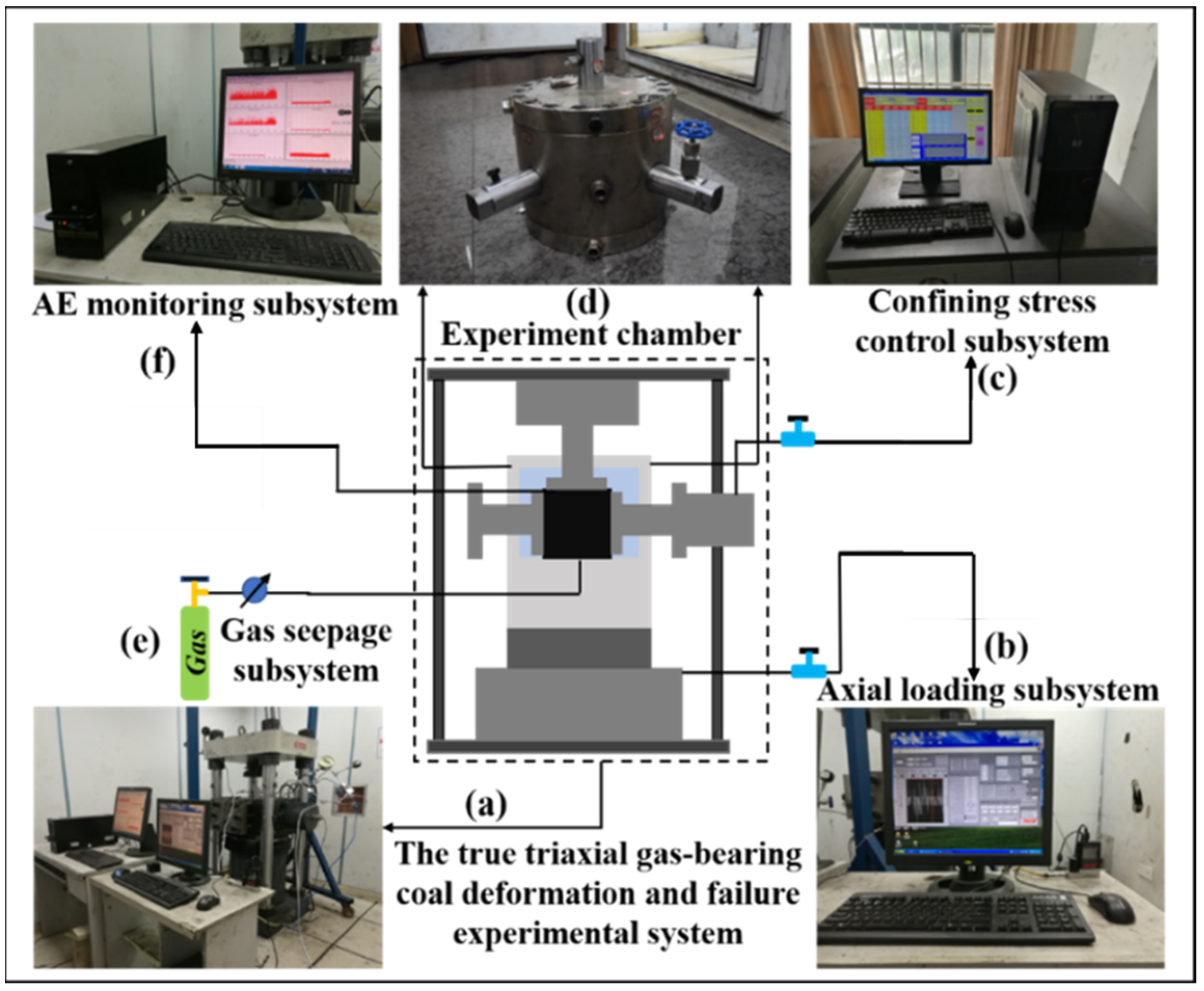
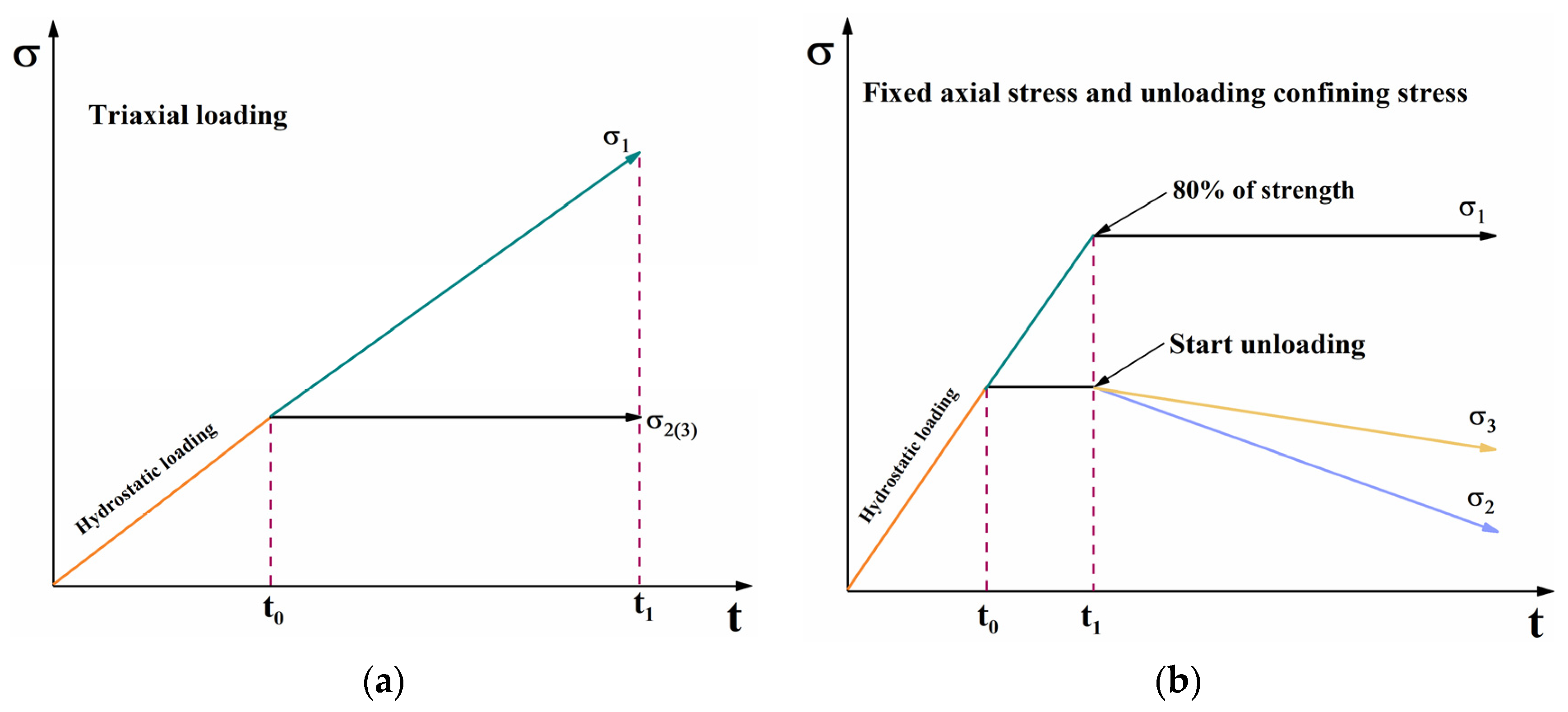
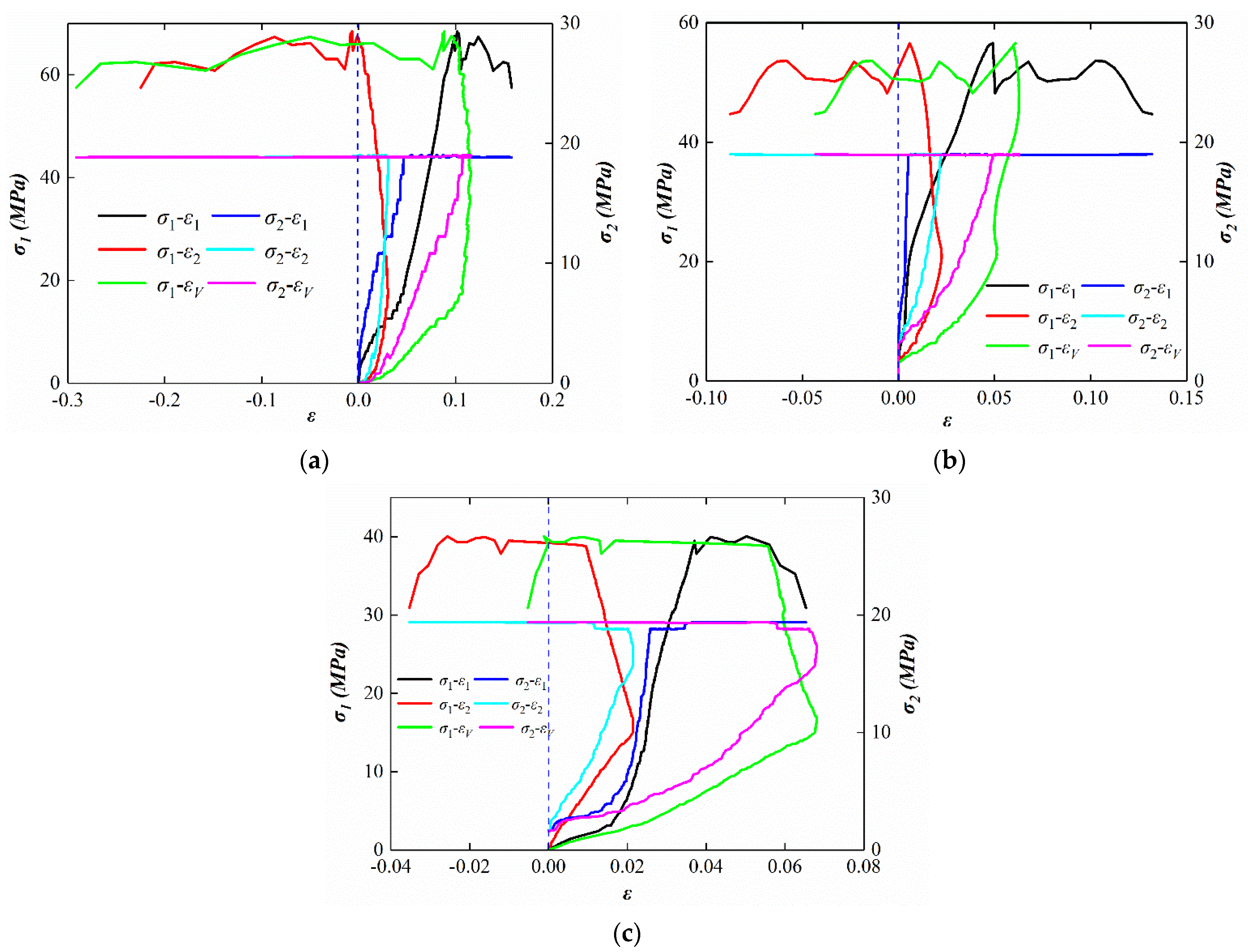

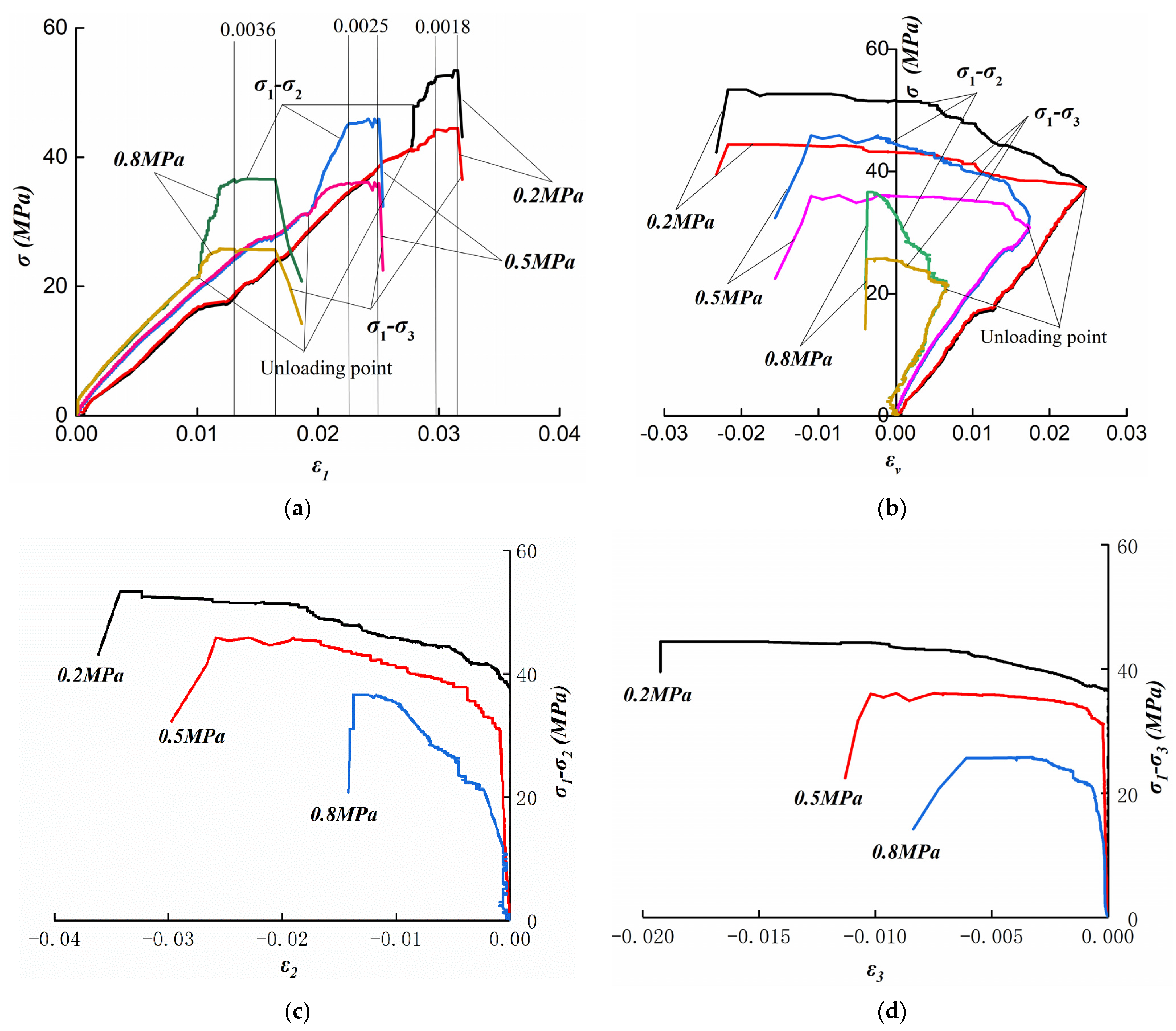
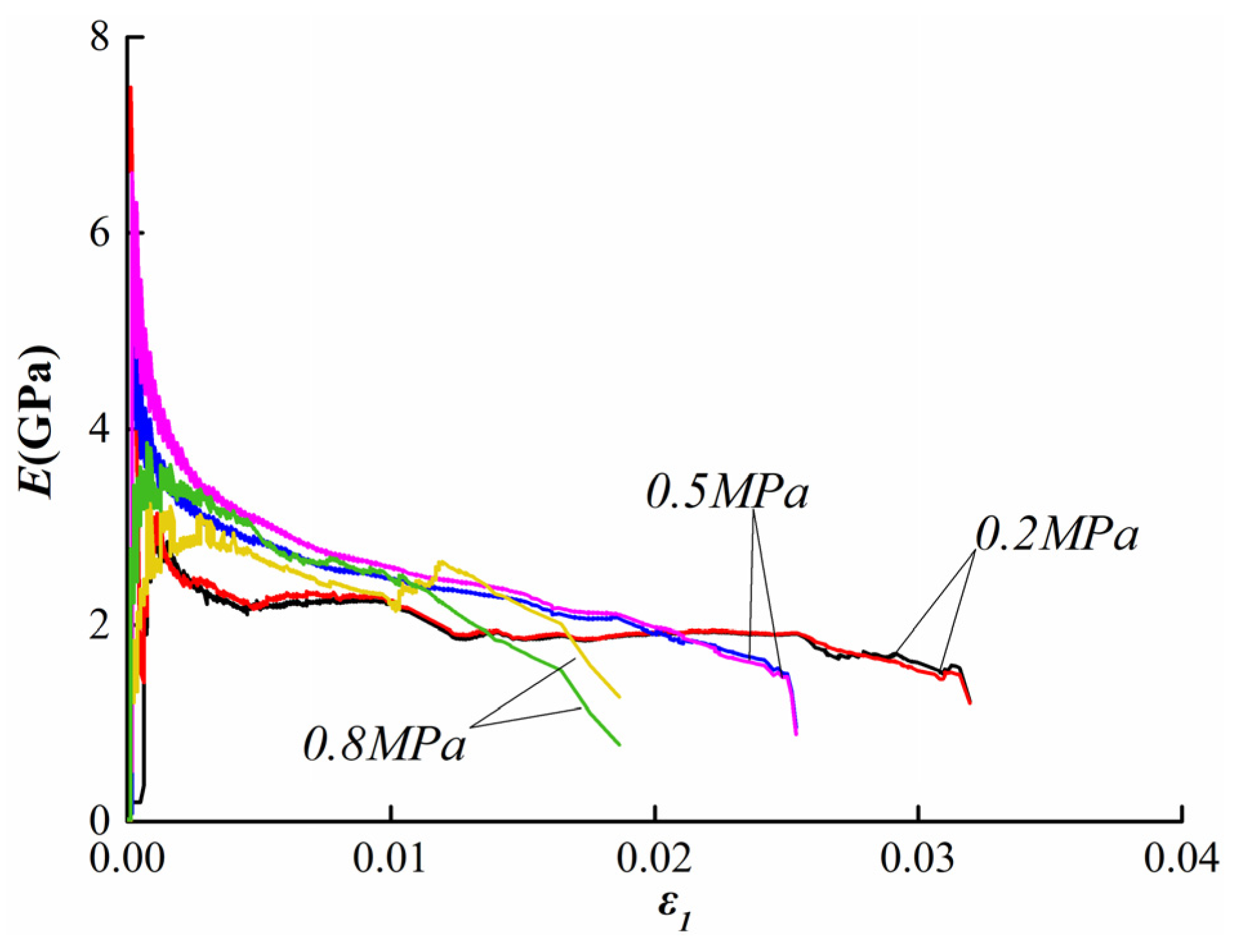
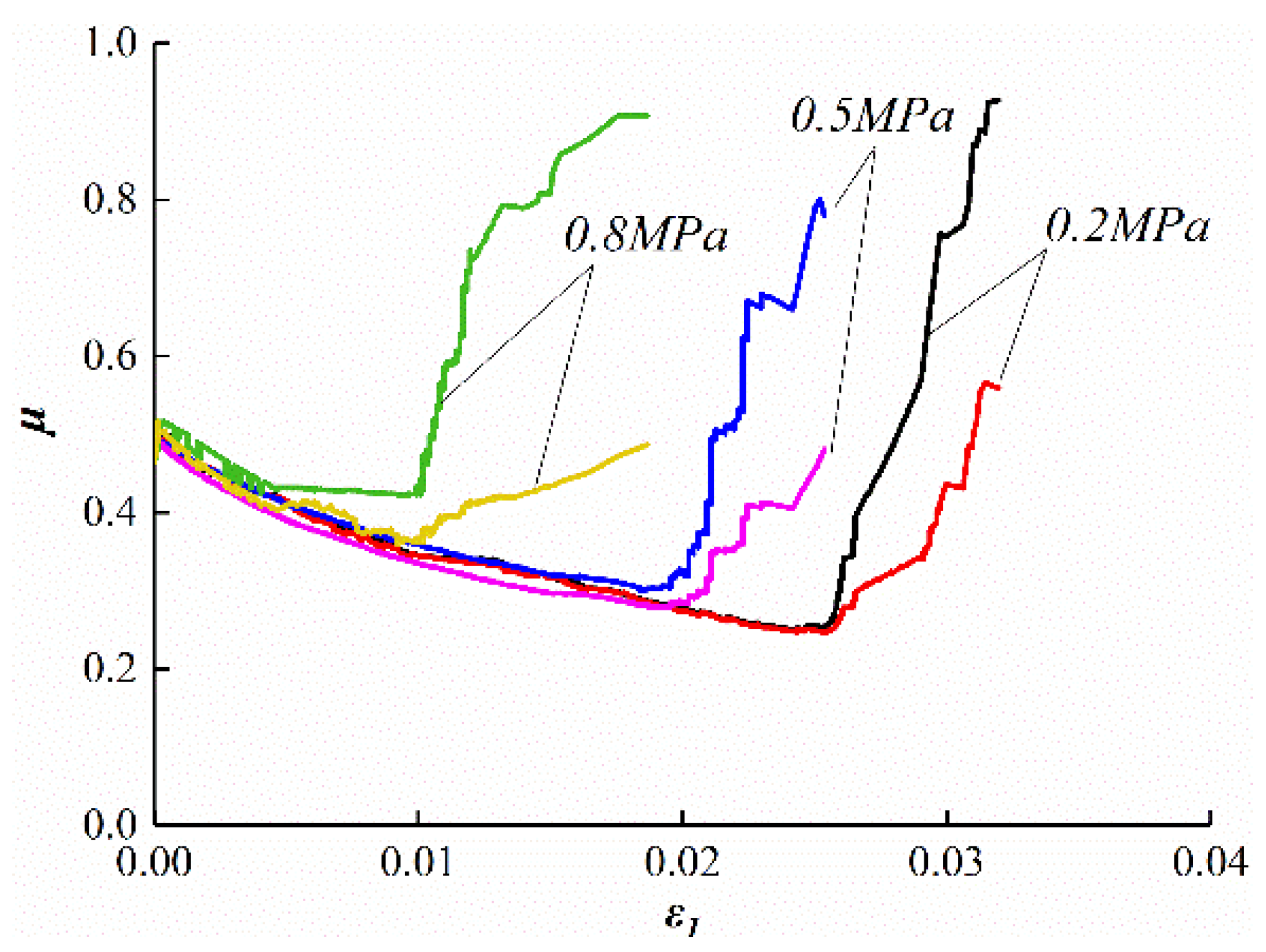
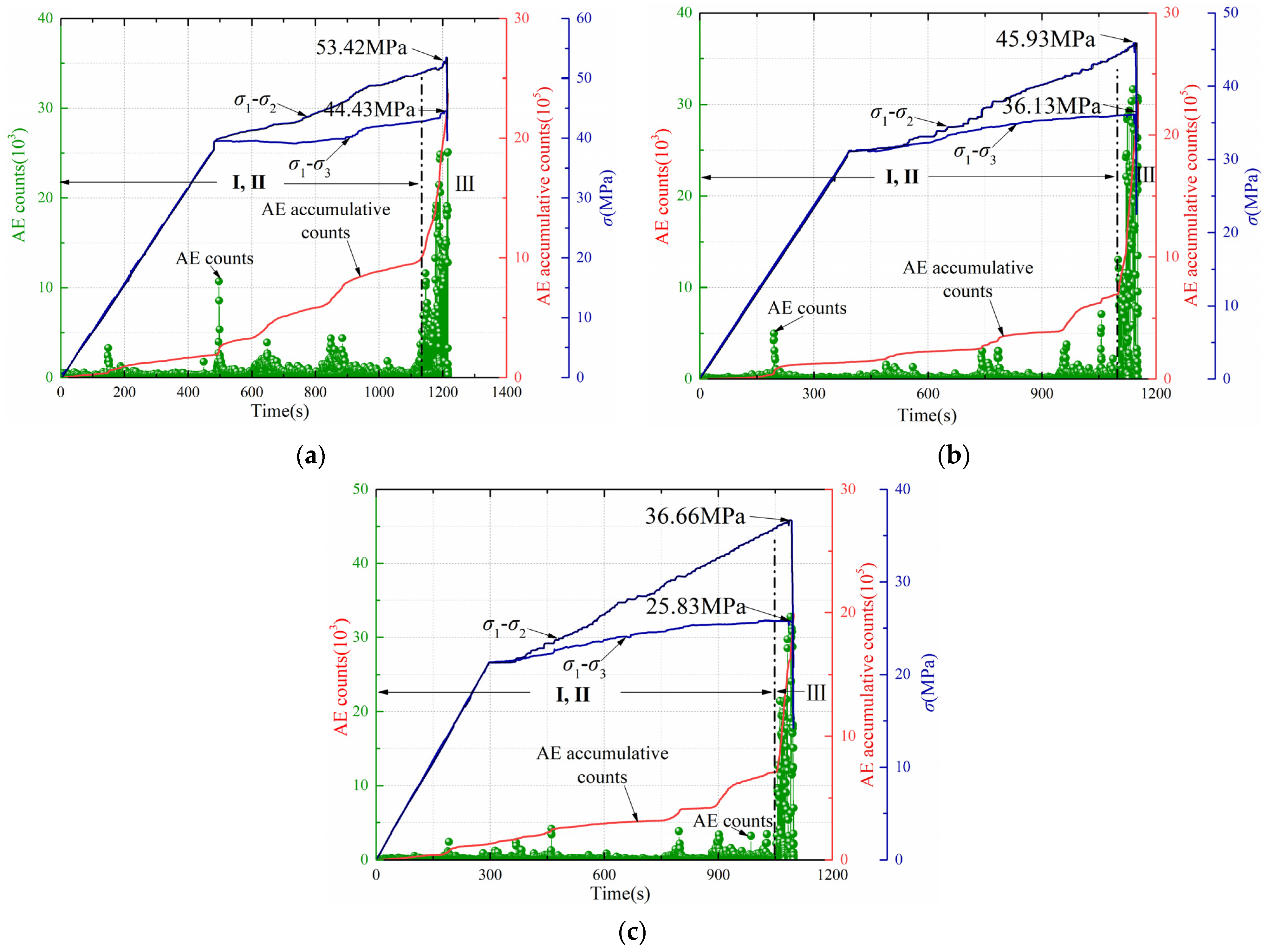
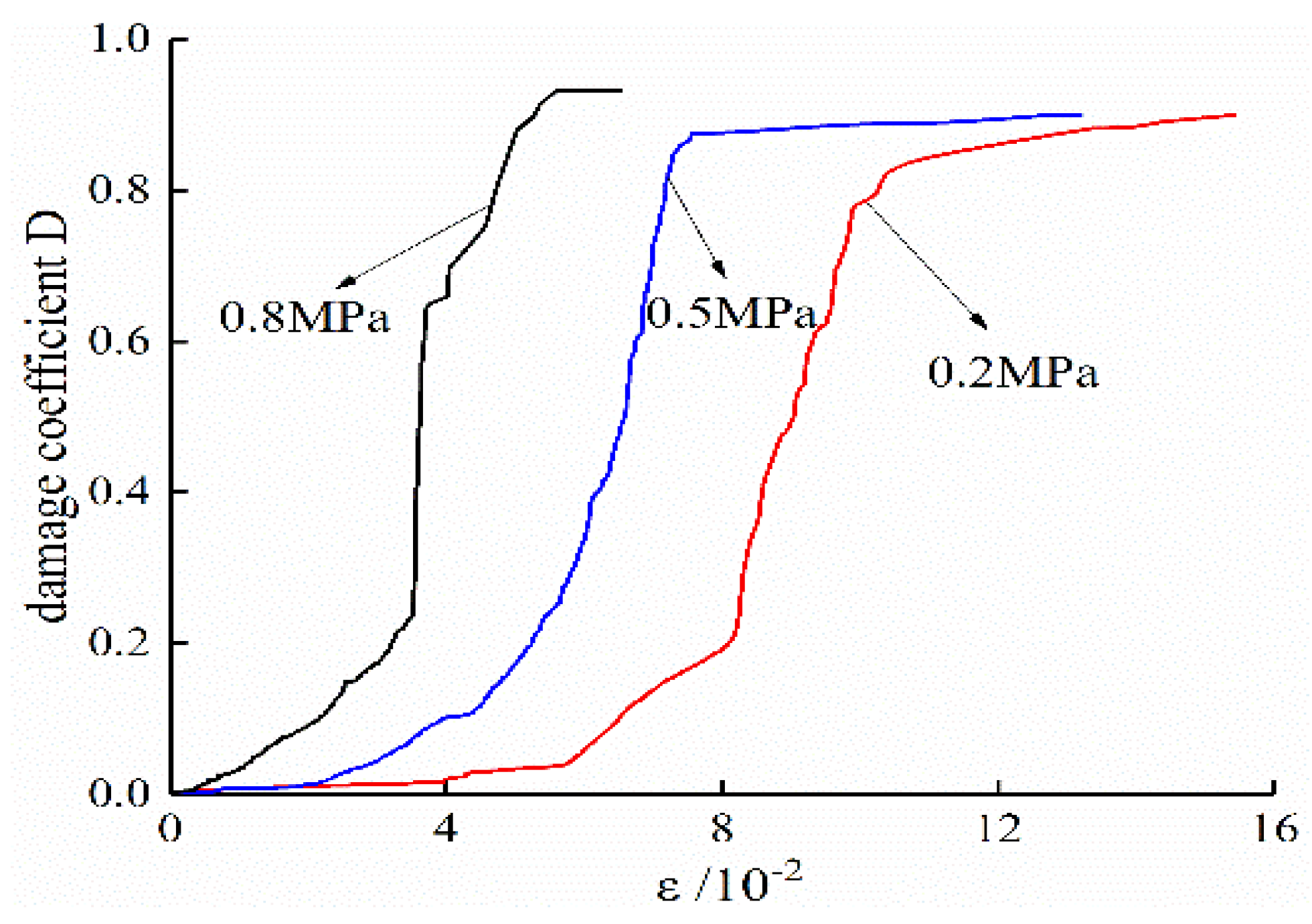


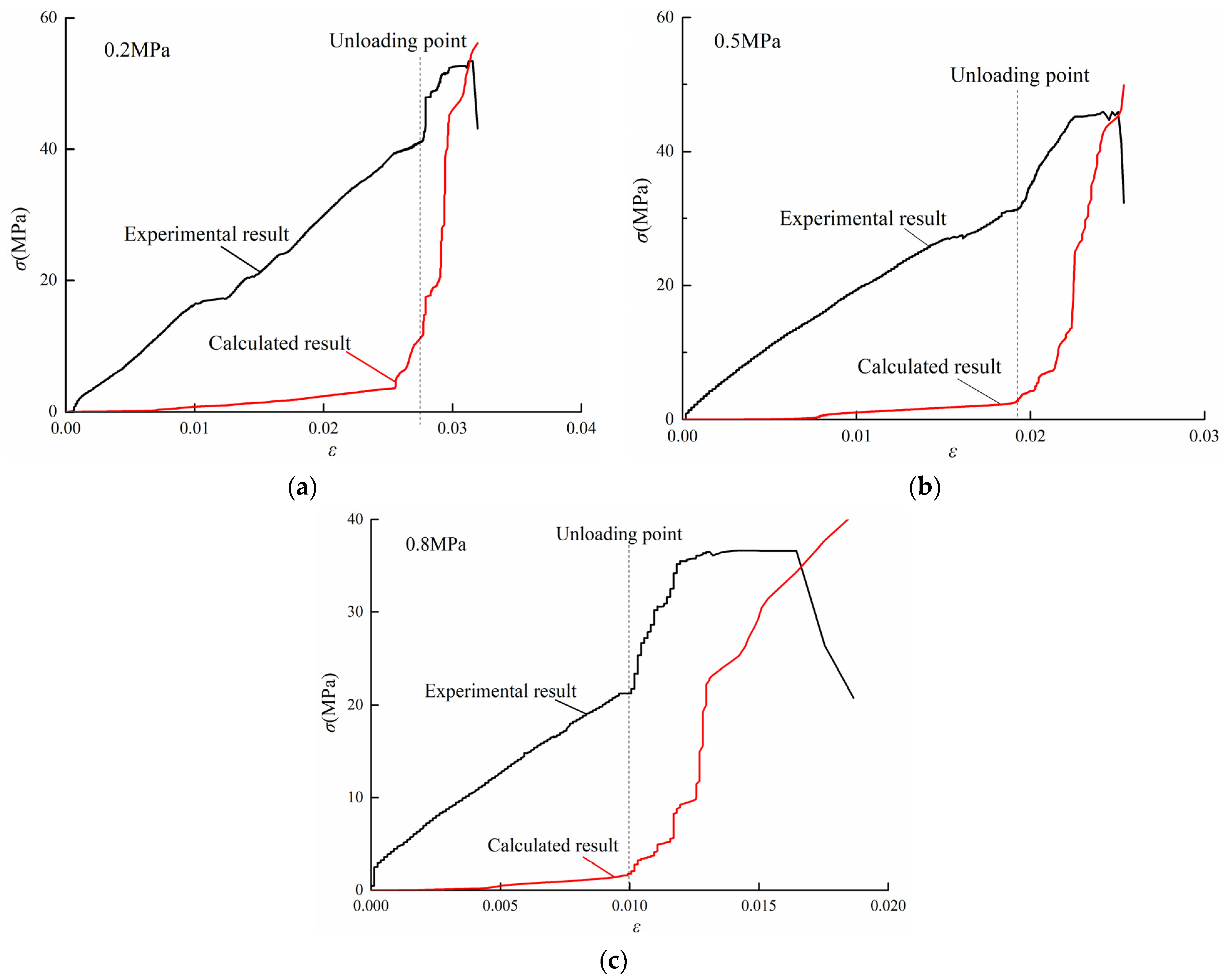

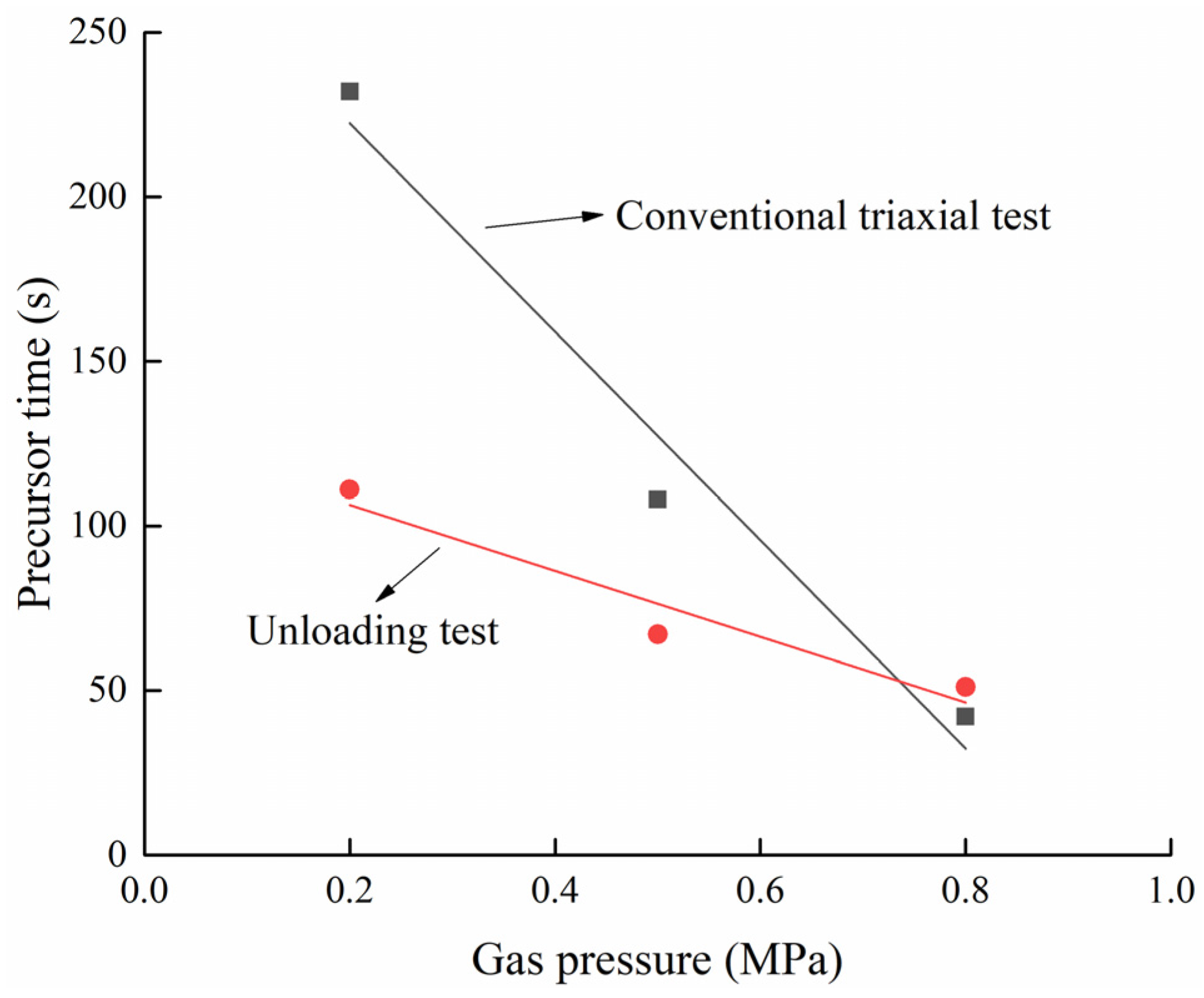
| Loading Mode | Number | Gas Pressure (MPa) | Confining Stress (MPa) | ||
|---|---|---|---|---|---|
| Conventional triaxial loading | 1 | 0 | 19 | None | None |
| 2 | 0 | ||||
| 3 | 0 | ||||
| 4 | 0.2 | 19 | None | None | |
| 5 | 0.2 | ||||
| 6 | 0.2 | ||||
| 7 | 0.5 | 19 | None | None | |
| 8 | 0.5 | ||||
| 9 | 0.5 | ||||
| 10 | 0.8 | 19 | None | None | |
| 11 | 0.8 | ||||
| 12 | 0.8 | ||||
| Fixed axial stress and unloading confining stress | 13 | 0.2 | 19 | 0.01 | 0.005 |
| 14 | 0.2 | ||||
| 15 | 0.2 | ||||
| 16 | 0.5 | 19 | 0.01 | 0.005 | |
| 17 | 0.5 | ||||
| 18 | 0.5 | ||||
| 19 | 0.8 | 19 | 0.01 | 0.005 | |
| 20 | 0.8 | ||||
| 21 | 0.8 |
Publisher’s Note: MDPI stays neutral with regard to jurisdictional claims in published maps and institutional affiliations. |
© 2022 by the authors. Licensee MDPI, Basel, Switzerland. This article is an open access article distributed under the terms and conditions of the Creative Commons Attribution (CC BY) license (https://creativecommons.org/licenses/by/4.0/).
Share and Cite
Liu, J.; Li, Q.; Li, J.; Wang, Z.; Lu, S. Experimental Investigation on Mechanical and Acoustic Emission Characteristics of Gassy Coal under Different Stress Paths. Int. J. Environ. Res. Public Health 2022, 19, 7873. https://doi.org/10.3390/ijerph19137873
Liu J, Li Q, Li J, Wang Z, Lu S. Experimental Investigation on Mechanical and Acoustic Emission Characteristics of Gassy Coal under Different Stress Paths. International Journal of Environmental Research and Public Health. 2022; 19(13):7873. https://doi.org/10.3390/ijerph19137873
Chicago/Turabian StyleLiu, Jie, Qiuping Li, Jinduo Li, Zaiquan Wang, and Shouqing Lu. 2022. "Experimental Investigation on Mechanical and Acoustic Emission Characteristics of Gassy Coal under Different Stress Paths" International Journal of Environmental Research and Public Health 19, no. 13: 7873. https://doi.org/10.3390/ijerph19137873
APA StyleLiu, J., Li, Q., Li, J., Wang, Z., & Lu, S. (2022). Experimental Investigation on Mechanical and Acoustic Emission Characteristics of Gassy Coal under Different Stress Paths. International Journal of Environmental Research and Public Health, 19(13), 7873. https://doi.org/10.3390/ijerph19137873






